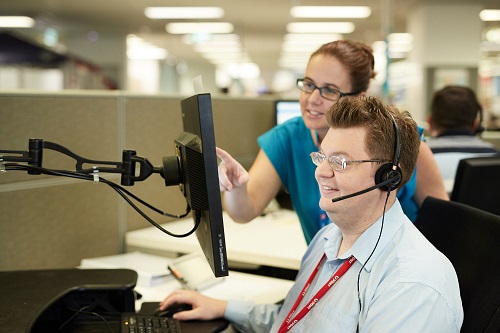There is no escaping that COVID-19 has had a colossal impact on Australian workplaces.
Yet while the last two years have seen a shift in thinking towards remote working and the need for flexibility, disappointingly there seems to be little change when it comes to including people with disability in workplaces.
Although an estimated one in five Australians live with a disability, they are neglected and underrepresented in the corporate environment.
Many face unfair barriers including employer attitudes, inaccessible offices or systems, and unsupportive workplaces. Just 24% of Australians who are blind or have low vision are in fulltime employment.
Like everyone else, people who are blind or have low vision, or live with any other disability, have a need and desire to work and achieve their professional goals.

Caption: People who are blind or have low vision have the same desire to achieve their professional goals as anyone else.
Disability employment targets
Diversity has been a buzzword attached to employment for several years, yet progress is still slow when it comes to actually building diverse and inclusive workplaces.
Recent research by Vision Australia reveals a significant proportion of employers hold negative perceptions about people who are blind or have low vision, including that they’re a burden, unproductive, a health and safety risk, and more.
These outdated perceptions are prevalent across workplaces of all sizes in Australia. A significant portion of employers revealed they had never considered hiring someone who is blind or with low vision.
Disappointingly, many said they would be unwilling to change job requirements for someone who is blind or has low vision even if they were fully qualified for the position.
What’s concerning is that these attitudes are prevalent when so many workplaces boast of their disability employment targets.
Attitudes like this give such targets little chance of success and mean they little more than tokens. It’s long overdue for employers to look inward and ensure they have plans and policies in place to meet disability targets and pay more than just lip service to the ideals of diversity and inclusion.

Caption: Employers need to ensure people with disability are put in the position to fully participate and succeed in the workplace.
Our experience
At Vision Australia, we take pride in being a leading national provider of blindness and low vision services and we’re committed to creating a more inclusive workforce through our practice.
Of our 800 employees, 15% are people who are blind or have low vision. This ranges from frontline service providers through to departmental managers, all the way to our senior leadership team.
We are extremely proud of the workforce we have developed and the work we have done to achieve that.
Our 15% figure is a set organisation KPI that our leadership team closely follows and adheres to throughout our employment process.
We take an affirmative approach by encouraging blind and low vision people to apply for positions and considering them when they do.
Our application portal is also designed to be accessible to those living with a disability to make the process as seamless as possible.
But simply hiring someone who is blind or has low vision, or lives with any other disability is of little good if they aren’t put in a position to succeed.
Vision Australia, we strive to support blind and low vision people in the workplace, with our office spaces designed with built environments that meet their needs.
Additionally, we provide assistive technology that helps our employees perform their tasks independently.
We ensure our staff can continue vital training, such as orientation and mobility by providing additional leave. We’re also constantly educating our sighted staff about what it means to work alongside someone who is blind or has low vision.
But organisations like ours should not be the only avenue to a career for someone with a disability. Somebody who is blind or have low vision should feel comfortable and confident they can pursue their career in any workplace across Australia.
Caption: People with disability may use different equipment or processes in the workplace, but that doesn't take away from their ability to contribute to an organisation.
A time for real change
Diversity means a different thing for every organisation, whether that’s gender, age, race, or disability, a representative workforce has several benefits.
At Vision Australia, our employees ensure we’re meeting the needs of people who are blind or have low vision, and we’re committed to constantly meeting our targets and striving to become more representative.
But the word diversity is meaningless unless there is planned action behind it. Without committed processes, policies, or systems in place, you will fail to build a representative workforce that is inclusive of every person.
As Australia emerges further out a period of disruption, we must strive to move past tokenistic targets and ensure we are bringing about positive change.










